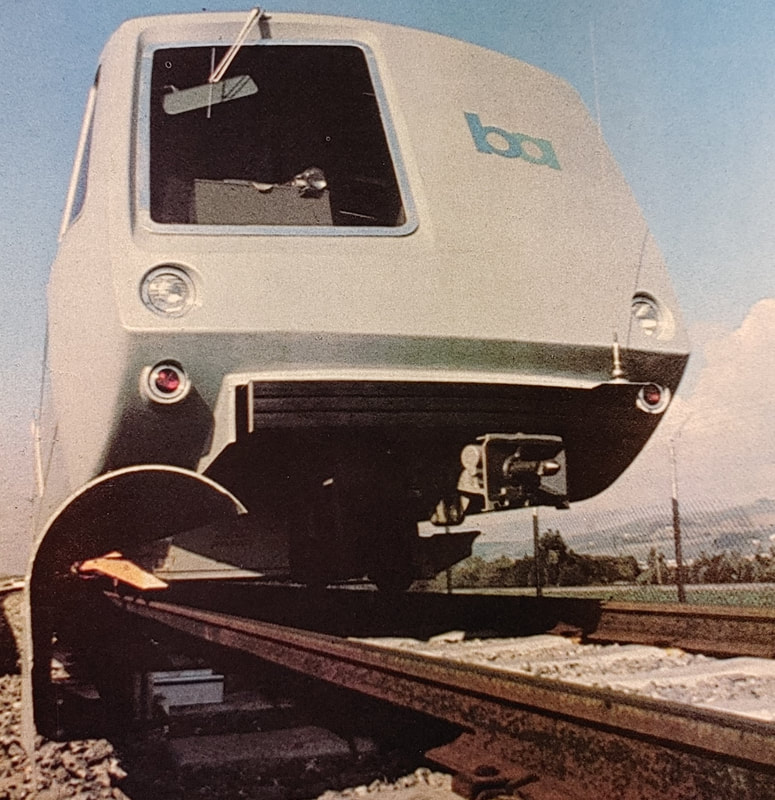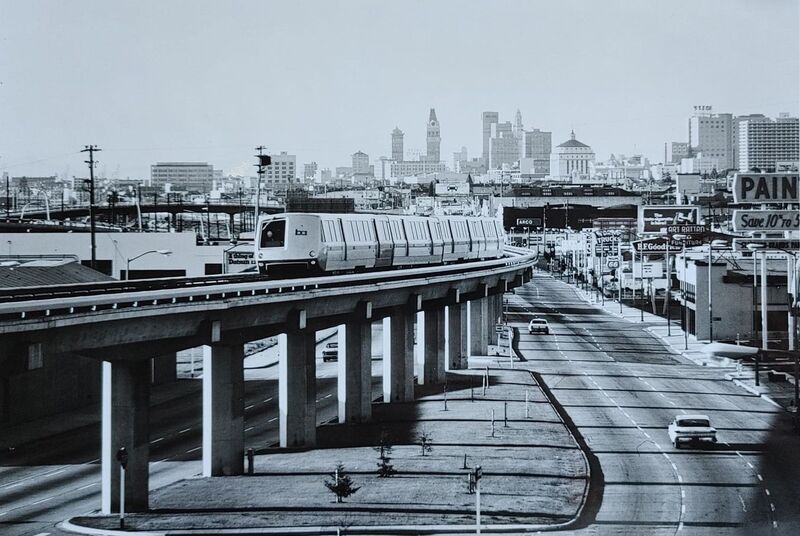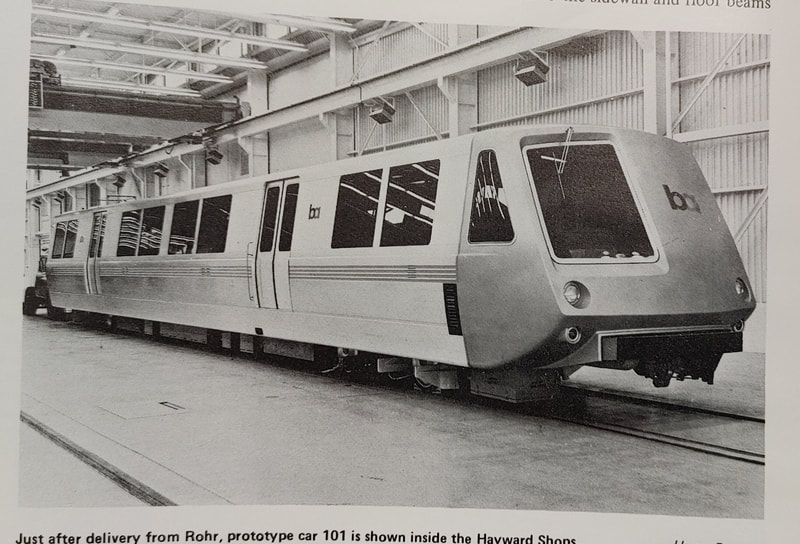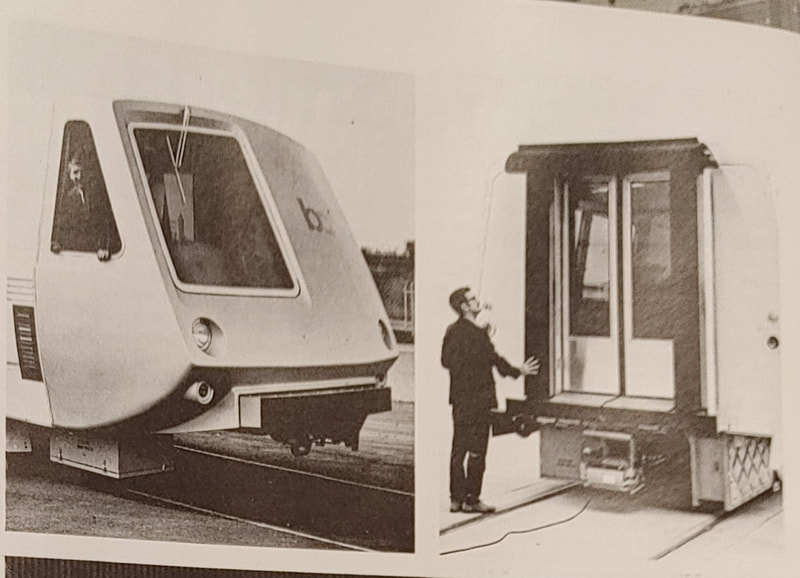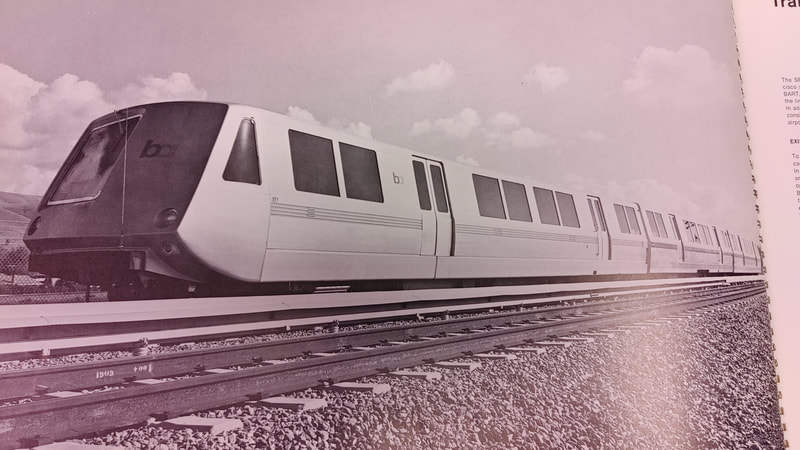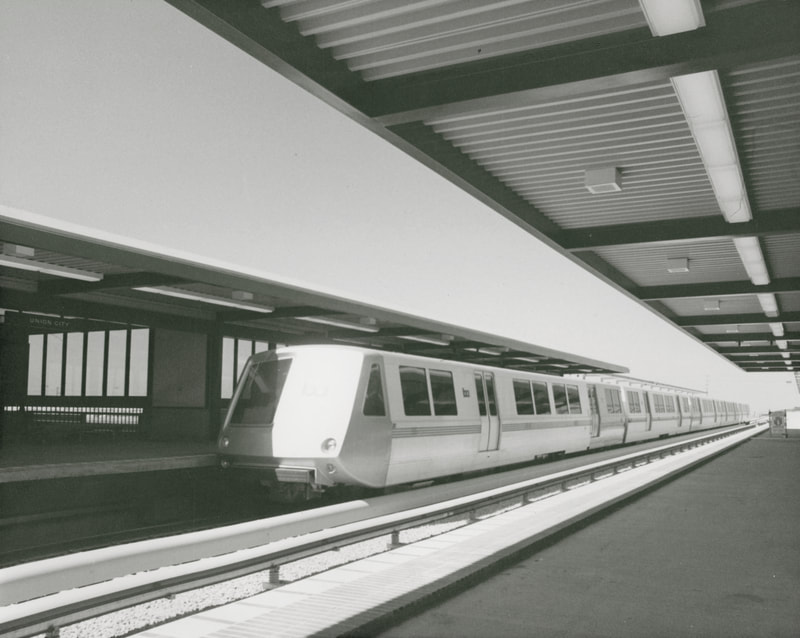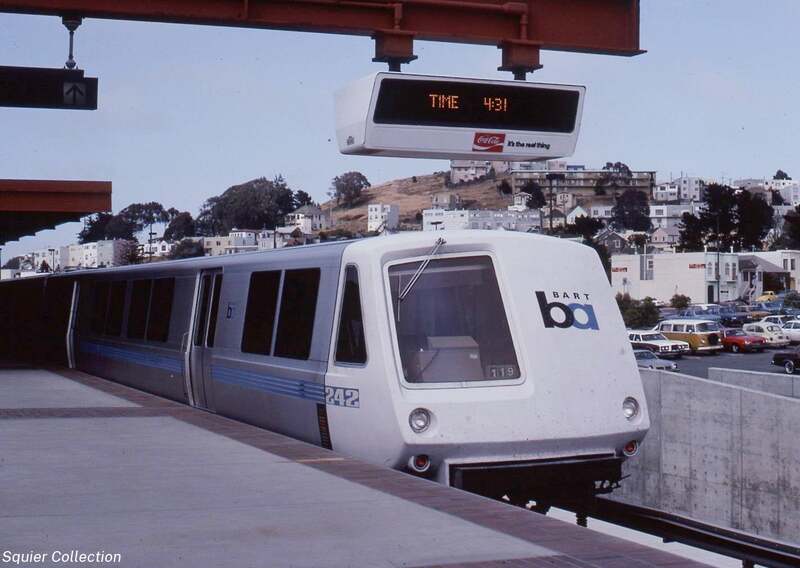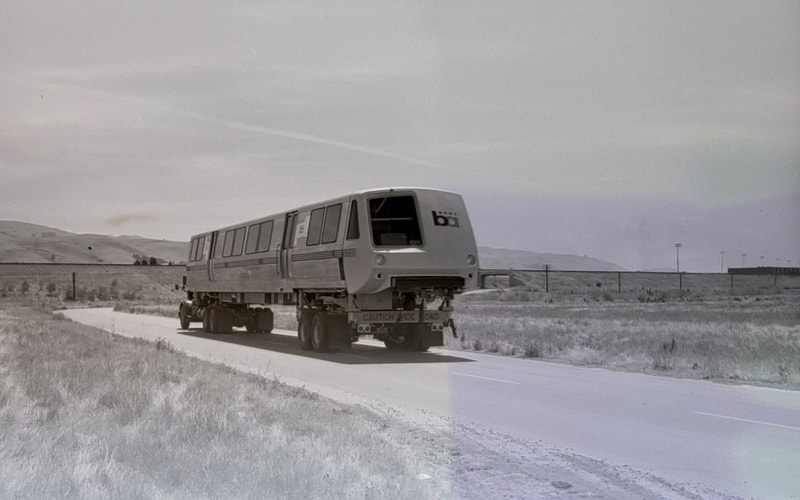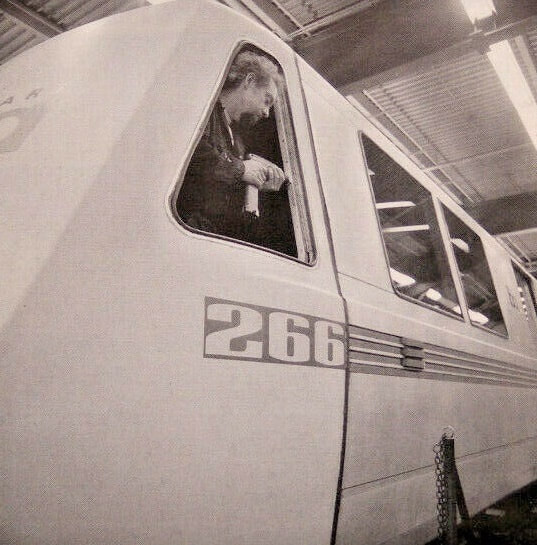|
The iconic slant-nosed A car is the face of BART, past and present. The original A cars, discussed here, were the lead and trail cars of every BART train for the first decade of operation.
A cars had a sloped fiberglass cab, which contained train control equipment, allowing the train to be operated in manual and automatic modes. They were only used as lead or trailing units in revenue service. For more details on the design of the BART car, see the Design page. For very technical details on the original A and B cars, see the page Rohr: Background on the BART Car. In 1978-1981, and again in 1993, a total of 37 A cars were converted into B cars. The midlife rebuilding process also included a further 76 A cars converted into B cars, or in this case, B2 Cars. The remaining 59 A cars were rebuilt into the A2 Cars, many of which still roll today. For more details on this processs, see the rebuilding page for information on the rebuilding process, and the A to B conversion page on the conversion story. |
Design
|
The Rohr built A car was an evolution of the A car mockup of 1965. The following description first pertains to the mockup 814, when it was unveiled to the public, followed by the car itself:
Starting with the overall objectives and constraints for the BART system, Sundberg-Ferar Industrial Design of Detroit, and St Louis Car Division of General Steel Industries of Granite City, IL, designed the aesthetic and human engineering aspects of the BART vehicle. The design of the mockup, undertaken by Sundberg-Ferar, was the product of many rounds of renderings, models, and collaboration with car builders. This cycle of collaboration between all parties allowed for a more seamless connection to the construction of the actual revenue cars. The car itself was manufactured by W. Ashley Gray Jr. of St Louis Car Division of General Steel Industries, for a cost of $400,000. |
As noted during the unveiling of the car at the Diablo Test Track on June 22, 1964, the BART car was to represent the best of BART, and functions as a symbol of the entire BART project. As said by General Manager B.R. Stokes:
This design car epitomizes more than anything else our goal of providing the most comfortable, fastest, safest and most economical means of interurban transportation the world has ever known.
Our entire purpose in life, our only reason for existence, is to produce a system so inviting that Bay Area travelers will choose to ride the 80 mile-an-hour trains instead of adding to the traffic congestion that has had such an undesirable effect on our urban way of life…
The car we have unveiled here today is destined to establish an exciting new trend in rapid transit conveyances…This is not just a warmed over version of an existing commuter train. It's entirely new - the first in over a quarter of a century. There's nothing to compare it with for comfort and luxury, except possibly a jet airliner or the most expensive automobile.
Designer Carl Sundberg explained the design process of the car. The following is a transcription from his own words:
…We began the design process with the most essential ingredient, the human being, tailoring all elements to his or her needs. We knew, also, that the people of the Bay Area traditionally accept newness, that they do, in fact, hunger for innovation.
We gave the nose a sophisticated, sculptured look, yet we kept it simple; we used no gimmicks or clichés strictly for the sake of appearance. We wanted a modern vehicle, yet we stuck to the contention that a rapid transit train should look like a rapid transit train, and nothing else.
We wanted the car to appeal to all ages and walks of life, so we gave it a fleet look to reach the younger generation, yet a solid, practical, even dignified look to appeal to adults.
It was our purpose to make the interior of the car, as well as the exterior, competitive in design and comfort features with the most expensive automobile.
This, I feel, we have done.
The 1.10 car mockup was displayed across the San Francisco Bay Area before the opening of the system. Hundreds of thousands of future riders provided their comments to help shape the human element of the BART railcar. The mockup also trekked down to Los Angeles, to help drum up support for a heavy rail system in their vicinity.
On the technical side, the BART car was designed to be the most advanced rapid transit car ever built.
The automatic train control (ATC) system was designed to run trains at speeds up to 80 mph between stations, and bring them to a stop with the precision of plus or minus six inches. BART was the first rapid system to have the merging of multiple lines under ATC.
The car was built using extruded aluminum, contrasting to traditional sheet metal construction. These extruded aluminum pieces were combined to form a monocoque body shell. Although a rather new process for rail transit, these were proven techniques for the aerospace and aircraft industries.
All matters of truck design were considered as part of the Diablo Test Track project. By the time the revenue cars were built, the BART car was equipped with cast steel LFM-Rockwell inboard bearing trucks. The cars were equipped with automatically leveling air bag suspension, in addition to rubber bumpers, for a smooth ride.
The high performance characteristics of BART required a new propulsion system. Taking advantage of recent developments in chopper control and increases in thyristor ratings, the BART car became the first rapid transit car to employ such a system. Hydraulic disk braking was used on the cars, an offshoot of the technology developed for off-highway trucks and aircraft landing gear.
Together, the carbody, sans undercar equipment, weighed about 200 pounds per linear foot. The cab-equipped A car, with all equipment and empty of passengers, weighed approximately 59,000 pounds, while the cabless B car, similarly empty, weighed approximately 57,000 pounds. The respective weights per linear foot of car length (786.6 lb and 814.3 lb respectively) placed the BART cars as among the lightest rapid transit cars ever made.
The interior was designed to be relatively comfortable, and early reports firmly state the importance of a clean and pleasing interior for “evening and Sunday trips - to the theater for example – and by ladies in midday for shopping, etc.” The BART car was to have a positive and dignified look, neither extravagant nor draconian, but realistic to both the requirements for the wear and tear related to the operation of a transit system and the goal of competing against the commuter automobile, including the factor of comfort. The large windows, air conditioning, end-to-end carpeting, 72 upholstered seats, modern lighting, and other features all contributed to the idea that the BART car was to be a “public asset and a source of pride.”
In all, the design of the BART car combined both desires to provide a comfortable vehicle and a technologically advanced car in an attractive package. Certain aspects of the car would become industry standard, while other aspects were to be left as BART-only curiosities.
This design car epitomizes more than anything else our goal of providing the most comfortable, fastest, safest and most economical means of interurban transportation the world has ever known.
Our entire purpose in life, our only reason for existence, is to produce a system so inviting that Bay Area travelers will choose to ride the 80 mile-an-hour trains instead of adding to the traffic congestion that has had such an undesirable effect on our urban way of life…
The car we have unveiled here today is destined to establish an exciting new trend in rapid transit conveyances…This is not just a warmed over version of an existing commuter train. It's entirely new - the first in over a quarter of a century. There's nothing to compare it with for comfort and luxury, except possibly a jet airliner or the most expensive automobile.
Designer Carl Sundberg explained the design process of the car. The following is a transcription from his own words:
…We began the design process with the most essential ingredient, the human being, tailoring all elements to his or her needs. We knew, also, that the people of the Bay Area traditionally accept newness, that they do, in fact, hunger for innovation.
We gave the nose a sophisticated, sculptured look, yet we kept it simple; we used no gimmicks or clichés strictly for the sake of appearance. We wanted a modern vehicle, yet we stuck to the contention that a rapid transit train should look like a rapid transit train, and nothing else.
We wanted the car to appeal to all ages and walks of life, so we gave it a fleet look to reach the younger generation, yet a solid, practical, even dignified look to appeal to adults.
It was our purpose to make the interior of the car, as well as the exterior, competitive in design and comfort features with the most expensive automobile.
This, I feel, we have done.
The 1.10 car mockup was displayed across the San Francisco Bay Area before the opening of the system. Hundreds of thousands of future riders provided their comments to help shape the human element of the BART railcar. The mockup also trekked down to Los Angeles, to help drum up support for a heavy rail system in their vicinity.
On the technical side, the BART car was designed to be the most advanced rapid transit car ever built.
The automatic train control (ATC) system was designed to run trains at speeds up to 80 mph between stations, and bring them to a stop with the precision of plus or minus six inches. BART was the first rapid system to have the merging of multiple lines under ATC.
The car was built using extruded aluminum, contrasting to traditional sheet metal construction. These extruded aluminum pieces were combined to form a monocoque body shell. Although a rather new process for rail transit, these were proven techniques for the aerospace and aircraft industries.
All matters of truck design were considered as part of the Diablo Test Track project. By the time the revenue cars were built, the BART car was equipped with cast steel LFM-Rockwell inboard bearing trucks. The cars were equipped with automatically leveling air bag suspension, in addition to rubber bumpers, for a smooth ride.
The high performance characteristics of BART required a new propulsion system. Taking advantage of recent developments in chopper control and increases in thyristor ratings, the BART car became the first rapid transit car to employ such a system. Hydraulic disk braking was used on the cars, an offshoot of the technology developed for off-highway trucks and aircraft landing gear.
Together, the carbody, sans undercar equipment, weighed about 200 pounds per linear foot. The cab-equipped A car, with all equipment and empty of passengers, weighed approximately 59,000 pounds, while the cabless B car, similarly empty, weighed approximately 57,000 pounds. The respective weights per linear foot of car length (786.6 lb and 814.3 lb respectively) placed the BART cars as among the lightest rapid transit cars ever made.
The interior was designed to be relatively comfortable, and early reports firmly state the importance of a clean and pleasing interior for “evening and Sunday trips - to the theater for example – and by ladies in midday for shopping, etc.” The BART car was to have a positive and dignified look, neither extravagant nor draconian, but realistic to both the requirements for the wear and tear related to the operation of a transit system and the goal of competing against the commuter automobile, including the factor of comfort. The large windows, air conditioning, end-to-end carpeting, 72 upholstered seats, modern lighting, and other features all contributed to the idea that the BART car was to be a “public asset and a source of pride.”
In all, the design of the BART car combined both desires to provide a comfortable vehicle and a technologically advanced car in an attractive package. Certain aspects of the car would become industry standard, while other aspects were to be left as BART-only curiosities.
General Details
Builder: Rohr Industries, Inc. - (Employee memory site)
Location: Chula Vista Rohr Plant, Building 61
Years of Construction: 1970-1971 (Prototypes), 1971-1975 (Production)
Quantity: 7 Prototypes, 173 Production, 176 total fleet numbers/ordered (Numbered 101-176)
Length: 75 feet
Weight: 59,000-59,675 pounds (empty)
Seats: 72
Original Seat Manufacturer: American Seating Co
Propulsion: Westinghouse DC Chopper drive with 4 x 150 HP Westinghouse Model 1463 motors
Brakes: Hurst-Airheart (friction); dynamic brakes.
Motor Alternator: Safety Electric
HVAC: ThermoKing
Electronic Horn: Federal Signal
Air Horn: None (As Built, cars 101-250). Included on cars 251-276 as built and retrofitted to earlier cars.
Coupler: Wabco N3
Truck: LFM-Rockwell cast steel, model HPD-3
Location: Chula Vista Rohr Plant, Building 61
Years of Construction: 1970-1971 (Prototypes), 1971-1975 (Production)
Quantity: 7 Prototypes, 173 Production, 176 total fleet numbers/ordered (Numbered 101-176)
Length: 75 feet
Weight: 59,000-59,675 pounds (empty)
Seats: 72
Original Seat Manufacturer: American Seating Co
Propulsion: Westinghouse DC Chopper drive with 4 x 150 HP Westinghouse Model 1463 motors
Brakes: Hurst-Airheart (friction); dynamic brakes.
Motor Alternator: Safety Electric
HVAC: ThermoKing
Electronic Horn: Federal Signal
Air Horn: None (As Built, cars 101-250). Included on cars 251-276 as built and retrofitted to earlier cars.
Coupler: Wabco N3
Truck: LFM-Rockwell cast steel, model HPD-3
Prototype Cars (101-107), built 1970-1971
Click on each photo to view the full size image and credits.
These are the first cars of the legacy fleet, and even one of these A cars remains in service today as a B2 car.
BART received 10 cars from Rohr Industries between 1970 and 1971. These 10 cars, (7 (slant nosed) A cars nos 101-107 and 3 (midtrain) B cars nos 501-503) were prototypes for the production cars which arrived later.
The prototype program aimed to resolve planned and unplanned “bugs” of these new cars – from their construction, to their troubleshooting, in a similar vein to prototype aircraft (according to the Rohr car report).
The most striking aspect of these cars, in contrast to the production cars, were the liveries. Their logo, if included, was a lighter blue "b" with a teal "a," and no "B A R T" lettering.
101: Grey/silver painted cab, Logo. First A car, delivered August 1970
102: White cab, Logo
103: Blue cab, No logo
104: Large numbers (as used today – other cars had smaller numbers on the cab end/Y end), and logo
105: White cab, Logo
106: White cab, no Logo, unpainted feature line (stripes)
107: White cab, Logo
(By no means comprehensive – that’s just what I’ve found from the few photos of these cars – corrections and additional photos welcome)
Cars 103 and 105 were involved in a collision on November 2, 1971 – a two car train under manual control collided with a parked two car train. The attendant was injured, and the two colliding cars were written off.
The A cars – 101, 102, 104, 106 were scrapped after the competition of the prototype program. (A local newspaper called them “incomplete aluminum bodied cars, dented and battered by months of extensive testing…” (Demoro “BART Open House” 9/25/1971).
Car 107 was retained, and runs to this day. It was converted from an A car to a B2 (aka B2 car during its midlife overhaul by Adtranz in 1999, and runs today as car 1887.
The other 3 cars, B cars 501, 502, and 503 also survived, and were rebuilt in 1972. They were later rebuilt in 2000 by Adtranz, and remain rolling today as cars 1501, 1502, 1503.
BART received 10 cars from Rohr Industries between 1970 and 1971. These 10 cars, (7 (slant nosed) A cars nos 101-107 and 3 (midtrain) B cars nos 501-503) were prototypes for the production cars which arrived later.
The prototype program aimed to resolve planned and unplanned “bugs” of these new cars – from their construction, to their troubleshooting, in a similar vein to prototype aircraft (according to the Rohr car report).
The most striking aspect of these cars, in contrast to the production cars, were the liveries. Their logo, if included, was a lighter blue "b" with a teal "a," and no "B A R T" lettering.
101: Grey/silver painted cab, Logo. First A car, delivered August 1970
102: White cab, Logo
103: Blue cab, No logo
104: Large numbers (as used today – other cars had smaller numbers on the cab end/Y end), and logo
105: White cab, Logo
106: White cab, no Logo, unpainted feature line (stripes)
107: White cab, Logo
(By no means comprehensive – that’s just what I’ve found from the few photos of these cars – corrections and additional photos welcome)
Cars 103 and 105 were involved in a collision on November 2, 1971 – a two car train under manual control collided with a parked two car train. The attendant was injured, and the two colliding cars were written off.
The A cars – 101, 102, 104, 106 were scrapped after the competition of the prototype program. (A local newspaper called them “incomplete aluminum bodied cars, dented and battered by months of extensive testing…” (Demoro “BART Open House” 9/25/1971).
Car 107 was retained, and runs to this day. It was converted from an A car to a B2 (aka B2 car during its midlife overhaul by Adtranz in 1999, and runs today as car 1887.
The other 3 cars, B cars 501, 502, and 503 also survived, and were rebuilt in 1972. They were later rebuilt in 2000 by Adtranz, and remain rolling today as cars 1501, 1502, 1503.
Production Cars, Order I (2nd 101, 102, 104, 106; 108-250)
The production A cars of the first BART revenue car order were built between 1971 to 1973.
Production dates:
108-161: 1972
101, 102, 104, 106, 162-250: 1973
107: Built 1970-1971, rebuilt for revenue service in 1972-1973.
Various Notes:
108 - First production A Car. One of the first cars to cross the Transbay Tube, in June 1972.
111 - Displayed at TRANSPO 72.
114 - Lead car in the first revenue train under bay, September 1974.
116 - Runway car from MacArthur to Oakland Wye in Jan 1975.
120 - President Nixon rode this car
126 - Attempted another Fremont Flyer at A2 (18 mph speed code), twice, 2/26/76
143 - The Fremont Flyer
152 - Written off after collision and derailment with Hi Rail 544 on 1/19/75 (1 fatality)
164 - Hayward Test Track car
169 - Test car for light-grey painted cars 7/76.
184 - Destroyed in 1979 Transbay Tube fire
197 - Only surviving car of the ill-fated train of the 1979 Transbay Tube fire
226 - Part of derailment, 2/26/98, near Lafayette.
Production dates:
108-161: 1972
101, 102, 104, 106, 162-250: 1973
107: Built 1970-1971, rebuilt for revenue service in 1972-1973.
Various Notes:
108 - First production A Car. One of the first cars to cross the Transbay Tube, in June 1972.
111 - Displayed at TRANSPO 72.
114 - Lead car in the first revenue train under bay, September 1974.
116 - Runway car from MacArthur to Oakland Wye in Jan 1975.
120 - President Nixon rode this car
126 - Attempted another Fremont Flyer at A2 (18 mph speed code), twice, 2/26/76
143 - The Fremont Flyer
152 - Written off after collision and derailment with Hi Rail 544 on 1/19/75 (1 fatality)
164 - Hayward Test Track car
169 - Test car for light-grey painted cars 7/76.
184 - Destroyed in 1979 Transbay Tube fire
197 - Only surviving car of the ill-fated train of the 1979 Transbay Tube fire
226 - Part of derailment, 2/26/98, near Lafayette.
Click on each thumbnail to view the full size image and credits.
Production Cars, Order III (251-276)
The second order of Rohr cars included no A cars. The third and final order of Rohr cars included 26 A cars. These cars featured slight changes from the rest of the A cars. All A cars of this order were built in 1975, but due to reliability problems with the older A car fleet, they did not enter service until a few year later.
Differences included:
Various Car Notes:
253 - Last new Rohr car to be placed in service, 8/8/79.
262 - Pre-opening ceremony train for Dublin Line, 3/99.
Click on each photo to view the full size image and credits.
Differences included:
- Delivered with Air Horn
- Delivered with different cab visor
- Delivered without ATC Equipment (parts to be reused from the A to B conversion). At the time, BART was very unpleased with the reliability of the cars so far delivered, and these cars finally all entered service by 1979.
Various Car Notes:
253 - Last new Rohr car to be placed in service, 8/8/79.
262 - Pre-opening ceremony train for Dublin Line, 3/99.
Click on each photo to view the full size image and credits.
Sources:
BART Fleet List v5.6.8
Demoro, Harre W. “BART’s First Train Ends Work.” Oakland Tribune, December 1, 1971. Collection of: BARTD General Rolling Stock News, Norman Therkelson Collection, Prelinger Library
“Full-Scale Car for BARTD Is Unveiled” Passenger Transport, Volume 23, Number 12, New York, July 2, 1965. Pacific Bus Museum Collection
Grieg, Michael. “BART’s Dream Car: Luxury Route for Commuters.” June 23, 1965. Collection of: BARTD General Rolling Stock News, Norman Therkelson Collection, Prelinger Library
Lawson, K.L, Chief Equipment Engineer. “Development of the BARTD Vehicle.” Parsons Brinkerhoff-Tudor-Bechtel. May 5, 1966. Western Railway Museum, Bay Area Electric Railway Museum Archives, DB# 177437
“National Historic Mechanical Engineering Landmark.” San Francisco Bay Area Rapid Transit System
The American Society of Mechanical Engineers International, 1997.
BART Fleet List v5.6.8
Demoro, Harre W. “BART’s First Train Ends Work.” Oakland Tribune, December 1, 1971. Collection of: BARTD General Rolling Stock News, Norman Therkelson Collection, Prelinger Library
“Full-Scale Car for BARTD Is Unveiled” Passenger Transport, Volume 23, Number 12, New York, July 2, 1965. Pacific Bus Museum Collection
Grieg, Michael. “BART’s Dream Car: Luxury Route for Commuters.” June 23, 1965. Collection of: BARTD General Rolling Stock News, Norman Therkelson Collection, Prelinger Library
Lawson, K.L, Chief Equipment Engineer. “Development of the BARTD Vehicle.” Parsons Brinkerhoff-Tudor-Bechtel. May 5, 1966. Western Railway Museum, Bay Area Electric Railway Museum Archives, DB# 177437
“National Historic Mechanical Engineering Landmark.” San Francisco Bay Area Rapid Transit System
The American Society of Mechanical Engineers International, 1997.
Last updated: 6/4/23, 9/16/23, 9/23/23, 11/2/23, 12/12/23



